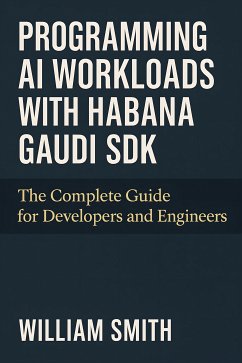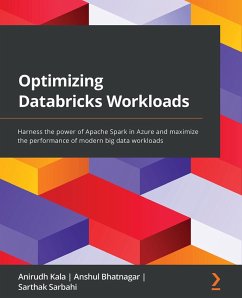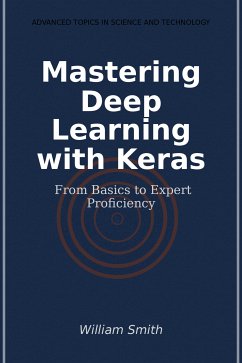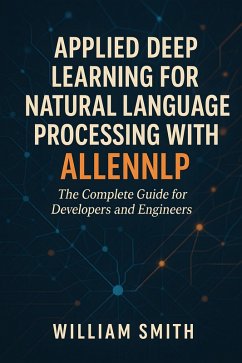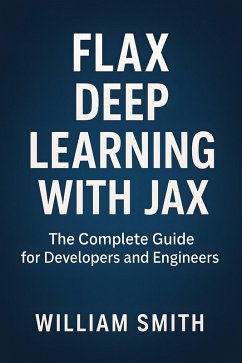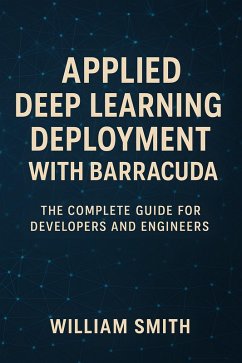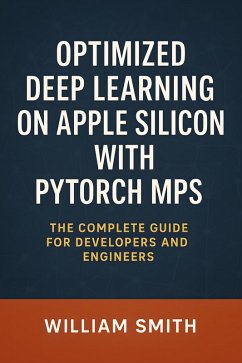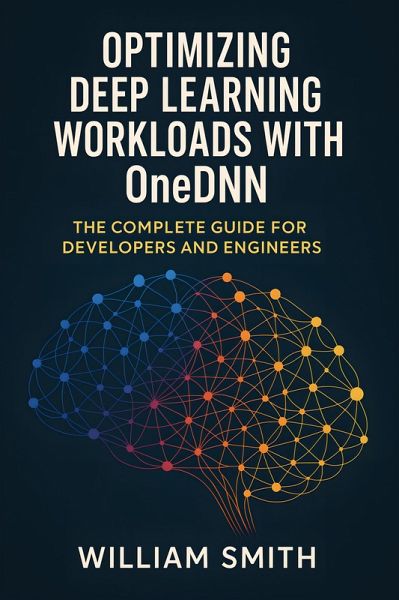
Optimizing Deep Learning Workloads with OneDNN (eBook, ePUB)
The Complete Guide for Developers and Engineers

PAYBACK Punkte
0 °P sammeln!
"Optimizing Deep Learning Workloads with OneDNN" "Optimizing Deep Learning Workloads with OneDNN" is an authoritative guide designed for professionals and researchers who seek to unlock the full computational potential of modern deep learning on CPUs and heterogeneous architectures. The book begins with a rigorous exposition of deep learning performance fundamentals, dissecting arithmetic intensities, memory and architectural considerations, and the translation of algorithmic complexity into real-world computational efficiency. Through detailed exploration of CPU microarchitectures, threading,...
"Optimizing Deep Learning Workloads with OneDNN"
"Optimizing Deep Learning Workloads with OneDNN" is an authoritative guide designed for professionals and researchers who seek to unlock the full computational potential of modern deep learning on CPUs and heterogeneous architectures. The book begins with a rigorous exposition of deep learning performance fundamentals, dissecting arithmetic intensities, memory and architectural considerations, and the translation of algorithmic complexity into real-world computational efficiency. Through detailed exploration of CPU microarchitectures, threading, memory hierarchies, and high-performance libraries such as OneDNN, readers gain a deep appreciation for the interplay between software design and hardware execution-a foundation that underpins production-grade machine learning systems.
Delving into OneDNN's architecture, the text provides a comprehensive walk-through of its abstraction layers, primitives, and backend interfaces, illuminating how OneDNN achieves portability, efficiency, and extensibility across CPUs and emerging accelerators. Readers will master the optimization of convolutions, tensor operations, fully connected layers, and normalization workflows through advanced techniques in primitive fusion, tiling, low-precision arithmetic, and multi-threading-backed by rich case studies and integration patterns with leading frameworks like TensorFlow, PyTorch, and ONNX. The book also emphasizes practical profiling methodologies, instrumentation, and systematic bottleneck analysis to facilitate informed, iterative performance tuning.
Beyond operational optimization, the book offers forward-looking chapters addressing the future of deep learning workloads: from embracing CPU+GPU+accelerator integration and dynamic neural networks, to hardware-aware AutoML, secure inference, and the evolving open-source ecosystem. Featuring in-depth technical analysis, practical workflows, and cutting-edge industry case studies, "Optimizing Deep Learning Workloads with OneDNN" empowers practitioners to build, deploy, and maintain high-throughput, scalable, and future-proof deep learning systems at both research and production scale.
"Optimizing Deep Learning Workloads with OneDNN" is an authoritative guide designed for professionals and researchers who seek to unlock the full computational potential of modern deep learning on CPUs and heterogeneous architectures. The book begins with a rigorous exposition of deep learning performance fundamentals, dissecting arithmetic intensities, memory and architectural considerations, and the translation of algorithmic complexity into real-world computational efficiency. Through detailed exploration of CPU microarchitectures, threading, memory hierarchies, and high-performance libraries such as OneDNN, readers gain a deep appreciation for the interplay between software design and hardware execution-a foundation that underpins production-grade machine learning systems.
Delving into OneDNN's architecture, the text provides a comprehensive walk-through of its abstraction layers, primitives, and backend interfaces, illuminating how OneDNN achieves portability, efficiency, and extensibility across CPUs and emerging accelerators. Readers will master the optimization of convolutions, tensor operations, fully connected layers, and normalization workflows through advanced techniques in primitive fusion, tiling, low-precision arithmetic, and multi-threading-backed by rich case studies and integration patterns with leading frameworks like TensorFlow, PyTorch, and ONNX. The book also emphasizes practical profiling methodologies, instrumentation, and systematic bottleneck analysis to facilitate informed, iterative performance tuning.
Beyond operational optimization, the book offers forward-looking chapters addressing the future of deep learning workloads: from embracing CPU+GPU+accelerator integration and dynamic neural networks, to hardware-aware AutoML, secure inference, and the evolving open-source ecosystem. Featuring in-depth technical analysis, practical workflows, and cutting-edge industry case studies, "Optimizing Deep Learning Workloads with OneDNN" empowers practitioners to build, deploy, and maintain high-throughput, scalable, and future-proof deep learning systems at both research and production scale.
Dieser Download kann aus rechtlichen Gründen nur mit Rechnungsadresse in A, B, BG, CY, CZ, D, DK, EW, E, FIN, F, GR, H, IRL, I, LT, L, LR, M, NL, PL, P, R, S, SLO, SK ausgeliefert werden.




